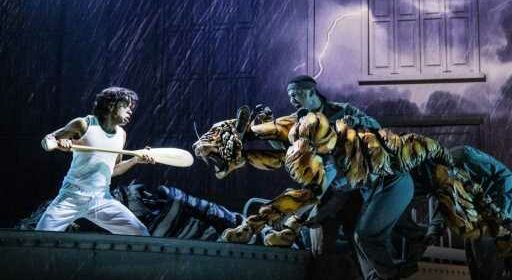The Secrets, Tricks and Cheats That Make a Puppet Scary in Broadway’s ‘Life of Pi’

Here are two wildlife facts you won’t learn in “Life of Pi”: Orangutans are quiet, and zebras stay silent when they’re attacked.
Listen to this week’s “Stagecraft” podcast below:
You’d never guess either of those things from Broadway’s “Life of Pi,” because the creators and puppeteers of the show use all manner of tools and tricks to make their animal puppets feel life-like — including having them behave in ways that aren’t life-like at all.
“Orangutans are very quiet beings,” explained Olivier Award-winning puppeteer Fred Davis on the new episode of Variety’s theater podcast, Stagecraft. “But if we had a very quiet orangutan for the duration of its time onstage, it wouldn’t have the same impact or believability as we need it to.”
The solution, then, was to take the limited array of orangutan noises that the show’s creators had observed in videos and documentaries, and, Davis said, “make them more frequently or for different reasons than an orangutan would in the wild.”
The production’s puppeteers bring a similar imaginative enhancement to an onstage zebra attack, which in real life would see the zebra fall silent rather than scream. “We had to use not puppetry technique, not animal research, but we had do a third thing: just make it theatrical,” said Finn Caldwell, the co-designer and co-movement director of “Life of Pi.”
On Stagecraft, Caldwell detailed the greatest challenge he faced in creating the show’s tiger, a central character portrayed by three puppeteers (including Davis at some performances) manipulating a life-size puppet. “The big ask, which we hadn’t really done anything like in my practice, was really making a frightening puppet,” Caldwell said. “A puppet that would frighten the young actor playing Pi and that would frighten the audience.” The effect is achieved in part through creature design — “big long teeth, scary eyes, dynamic snarls” — and in part by the quality of movement allowed by the bungee cords incorporated into the puppet’s solid-but-elastic body.
The evolution of the show’s puppets had a major influence on the script, noted playwright Lolita Chakrabarti. “The people in the play speak, and the animals speak in a different way,” she explained. “I worked really closely with Finn and Fred and the other puppeteers to work out what’s happening to the animal at [each] point, and how do we express that through language and through description so everybody knows what’s going on in a scene.”
Also on the new episode of Stagecraft, the show’s creators discussed the integral components of “contact puppetry,” revealed what challenges they’d like to tackle next, and gave a lesson on how hard it is to make the sound of a tiger’s growl.
To hear the full conversation, listen at the link above or download and subscribe to “Stagecraft” on podcast platforms including Apple Podcasts, Spotify and the Broadway Podcast Network. New episodes of “Stagecraft” are released every other week.
Read More About:
Source: Read Full Article